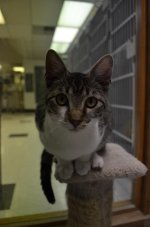You are using an out of date browser. It may not display this or other websites correctly.
You should upgrade or use an alternative browser.
You should upgrade or use an alternative browser.
Yellow tint on portions of photos
- Thread starter miss_paige
- Start date
The problem is your shutter speed is too fast and only captures a fraction of the yellow light of the fluorescent range. If you experiment, you should find which shutter speed (going slower) gets rid of this. Faster shutter speed and you'll get a smaller portion of the yellowish tint.
Horoscope Fish
Senior Member
Fluorescent lights flicker at a rate twice that of the frequency of the current powering them. This means one cycle (or flicker) will take between 1/100 and 1/120 second and during each cycle the intensity of the light, and its color temperature, will fluctuate. This being the case, using a shutter speed of 1/100 second or faster, you can expect to see this discoloration occur as your camera captures these differing intensities and color temperatures. Using flash would also alleviate the issue but I know flash is not always an attractive, or feasible, option.
....
....
sonicbuffalo_RIP
Senior Member
Fluorescent lights flicker at a rate twice that of the frequency of the current powering them. This means one cycle (or flicker) will take between 1/100 and 1/120 second and during each cycle the intensity of the light, and its color temperature, will fluctuate. This being the case, using a shutter speed of 1/100 second or faster, you can expect to see this discoloration occur as your camera captures these differing intensities and color temperatures. Using flash would also alleviate the issue but I know flash is not always an attractive, or feasible, option.
....
Is that why they named Flicker, Flickr? lol
Horoscope Fish
Senior Member
*facepalm*Is that why they named Flicker, Flickr? lol
Yes. Yes it is...
Fluorescent lights flicker at a rate twice that of the frequency of the current powering them. This means one cycle (or flicker) will take between 1/100 and 1/120 second and during each cycle the intensity of the light, and its color temperature, will fluctuate. This being the case, using a shutter speed of 1/100 second or faster, you can expect to see this discoloration occur as your camera captures these differing intensities and color temperatures. Using flash would also alleviate the issue but I know flash is not always an attractive, or feasible, option.
....
Fluorescent lights
This is written assuming 60 Hz household power in North America (many other locations are 50 Hz.. If applicable, replace 1/60 with 1/50 in the text below).
Shutter speed under ballast type fluorescent lights really should be exactly 1/120 or 1/60 second (again, assuming 60Hz house current). The color varies with peak or valley of the 60 Hz voltage waveform (flicker). A 1/100 second, or faster 1/180 or 1/400 second shutter captures only partial 60 or 120 Hz cycles, which could miss the voltage peak, and can affect color (and illumination). Shutters much slower will capture many cycles, and little errors sort of wash out (but even divisions of 1/60 are a good thing, 1/30, 1/20, 1/15, 1/10, etc. but maybe not 1/25).
Many fluorescent lights today (such as all CFL bubs) have semiconductor power converters, and run at high frequency - a few thousand Hz instead of low 60 Hz house current. So then this flicker becomes not a problem for photography (white balance might still be a big issue, but not flicker).
The old magnetic ballast type of fluorescents are the problem (operating at house 60Hz frequency). However, newer ceiling light fixtures (since the 90s) might be semiconductor frequency instead of magnetic ballast (or might not be), and like CFL, these are not a problem either. Only the old magnetic ballast lights are a problem for shutter speed (all are a problem for white balance).
To determine which type of fluorescent you are shooting under, use a non-acceptable shutter speed, like say 1/100 or better 1/200 second (worse is better for the test). Aim camera at the bulb, and take maybe six pictures, click, click,click, etc. The color depends on white balance and may not be "correct", but if all are the same color, then no flicker, any shutter speed is OK.
But if these six vary, one or two are seriously different off-color (typically a dirty brown), that is flicker. To avoid that, instead use a shutter speed of 1/60 or 1/120 (or slower is not much problem either).
Fluorescent lights (Copied and modified for 50 Hz locations, like the UK)
Shutter speed under ballast type fluorescent lights really should be exactly 1/100 or 1/50 second (again, assuming 50Hz house current). The color varies with peak or valley of the 50 Hz voltage waveform (flicker). A faster 1/160 or 1/400 second shutter captures only partial 50 or 100 Hz cycles, which could miss the voltage peak, and can affect color (and illumination). Shutters much slower will capture many cycles, and little errors sort of wash out (but even divisions of 1/50 are a good thing, like 1/25 or 1/13 second).
Many fluorescent lights today (such as all CFL bubs) have semiconductor power converters, and run at high frequency - a few thousand Hz instead of low 50 Hz house current. So then this flicker becomes not a problem for photography (white balance might still be a big issue, but not flicker).
The old magnetic ballast type of fluorescents are the problem (operating at house 50Hz frequency). However, newer ceiling light fixtures (since the 90s) might be semiconductor frequency instead of magnetic ballast (or might not be), and like CFL, these are not a problem either. Only the old magnetic ballast lights are a problem for shutter speed (all are a problem for white balance).
To determine which type of fluorescent you are shooting under, use a non-acceptable shutter speed, like say 1/200 second (worse is better for the test). Aim camera at the bulb, and take maybe six pictures, click, click,click, etc. The color depends on white balance and may not be "correct", but if all are the same color, then no flicker, any shutter speed is OK.
But if these six vary, one or two are seriously different off-color (typically a dirty brown), that is flicker. To avoid that, instead use a shutter speed of 1/50 or 1/100 (or slower is not much problem either).
EDIT: I wish I had remembered to add: DO NOT USE AUTO WB for this flicker test. You want to see the real color.
Last edited:
Very useful indeed, thanks!
I have an interest in fish photography, Regarding fluorescent tank lighting, this either uses T8 or the newer T5 tubes. Should they both be treated in the same way? The very latest tank lighting uses LED usually of high quality. How should a photographer treat LED lighting?
I have an interest in fish photography, Regarding fluorescent tank lighting, this either uses T8 or the newer T5 tubes. Should they both be treated in the same way? The very latest tank lighting uses LED usually of high quality. How should a photographer treat LED lighting?
I don't know about your fish tank lights. It is not about the bulb, it is about the power supply. For example, CFL bulbs have a transistorized power supply built into their base, and they bypass this problem. Probably true of most small lights. Becoming more true of larger lights today.
You can simply do the quick test of about six quick photos at a faster shutter speed, like 1/200 second, to see if shutter speed is any issue or not. If not, then not.
LED lights run on DC and should not flicker. White balance is probably the main issue. Fluorescent and LED are not true continuous spectrum lights, not like hot filaments or our Sun are continuous spectrum. Fluorescent and LED use phosphor coatings to improve them.
You can simply do the quick test of about six quick photos at a faster shutter speed, like 1/200 second, to see if shutter speed is any issue or not. If not, then not.
LED lights run on DC and should not flicker. White balance is probably the main issue. Fluorescent and LED are not true continuous spectrum lights, not like hot filaments or our Sun are continuous spectrum. Fluorescent and LED use phosphor coatings to improve them.
Last edited:
I don't know about your fish tank lights. It is not about the bulb, it is about the power supply. For example, CFL bulbs have a transistorized power supply built into their base, and they bypass this problem.
You can simply do the quick test of about six quick photos at a faster shutter speed, like 1/200 second, to see if shutter speed is any issue or not. If not, then not.
Thanks Wayne.


